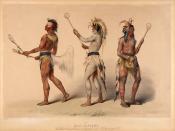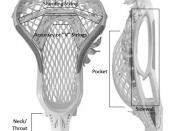Lacrosse was one of many varieties of indigenous stickball games being played by American
Indians at the time of European contact. Almost exclusively a male team sport, it is
distinguished from the others, such as field hockey or shinny, by the use of a netted racquet
with which to pick the ball off the ground, throw, catch and convey it into or past a goal
to score a point. The cardinal rule in all varieties of lacrosse was that the ball, with few
exceptions, must not be touched with the hands.
Early data on lacrosse, from missionaries such as French Jesuits in Huron country in the
1630s and English explorers, such as Jonathan Carver in the mid-eighteenth century Great
Lakes area, are scant and often conflicting. They inform us mostly about team size, equipment
used, the duration of games and length of playing fields but tell us almost nothing about
stickhandling, game strategy, or the rules of play.
The oldest surviving sticks date only
from the first quarter of the nineteenth century, and the first detailed reports on Indian
lacrosse are even later. George Beers provided good information on Mohawk playing techniques
in his Lacrosse (1869), while James Mooney in the American Anthropologist (1890) described
in detail the "[Eastern] Cherokee Ball-Play," including its legendary basis, elaborate rituals,
and the rules and manner of play.
Given the paucity of early data, we shall probably never be able to reconstruct the history of
the sport. Attempts to connect it to the rubber-ball games of Meso-America or to a perhaps older
game using a single post surmounted by some animal effigy and played together by men and women
remain speculative. As can best be determined, the distribution of lacrosse shows it to have
been played throughout the eastern half of North America, mostly...


